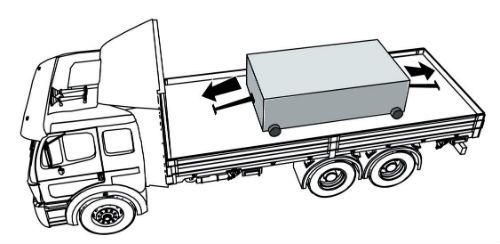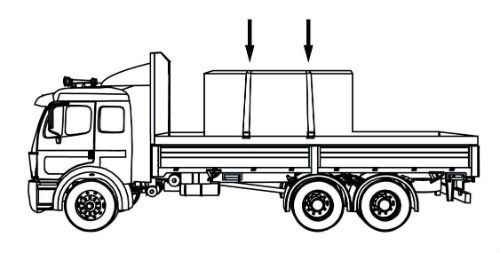CDL Practice Tests: Flatbed Cargo Securement
Choose A Section:
Go!Cargo securement for a load weighing 37,000 lbs must be able to withstand a minimum forward braking force of:
- 7,400 lbs
- 18,500 lbs
- 10,000 lbs
- 29,600 lbs
How well must the securement system work? (Section 1.3)
Each cargo securement system must be able to withstand a minimum amount of force in each direction.
- Forward Force = 80% of cargo weight when braking while driving straight ahead.
- Rearward Force = 50% of cargo weight when accelerating, shifting gears while climbing a hill, or braking in reverse.
- Sideways Force = 50% of cargo weight when turning, changing lanes, or braking while turning.
-
Upward Force = 20% of cargo weight when traveling over bumps in the road or cresting a hill.
- This requirement is satisfied when the cargo is "Fully Contained."
Which of the following is not a reason why loads should be secured?
- Prevent loss of load
- Prevent damage to the cargo
- Make it look pretty
- Avoid fines and citations
Why secure your load? To prevent:
- Loss of life
- Loss of load
- Damage to the cargo
- Damage to the vehicle
- Issuance of citations/fines to driver/carrier
- The vehicle being placed Out-of-Service.
- A crash
Option #1 for securing coils transported with eyes lengthwise includes:
- It should include all of these things
- Attaching at least one tiedown diagonally from the right side of the vehicle, through the eye, to the left side of the vehicle
- Attaching at least one tiedown diagonally from the left side of the vehicle, through the eye, to the right side of the vehicle
- Using blocking or friction mats to prevent forward movement.
Tiedowns, Single Coil Option #1
Attach at least one tiedown diagonally from the left side of the vehicle, through the eye, to the right side of the vehicle. If possible, the angle between the tiedown and the deck should be less than 45, when viewed from the side of the vehicle.
Attach at least one tiedown diagonally from the right side of the vehicle, through the eye, to the left side of the vehicle. If possible, the angle between the tiedown and the deck should be less than 45, when viewed from the side of the vehicle.

Attach at least one tiedown side-to-side over the top of the coil.
Use blocking or friction mats to prevent forward movement.
As part of the log packing requirements:
- The center of the highest log on each side or end must be above the top of each stake, bunk, or standard.
- Outer bottom logs must be in contact with and rest solidly against bunks, bolsters, stakes, or standards.
- Logs must be loosely packed.
- Each inside log on the side of a stack of logs must touch at least two bunks, bolsters, stakes, or standards.
Packing requirements
- Logs must be solidly packed.
- Outer bottom logs must be in contact with and rest solidly against bunks, bolsters, stakes, or standards.
-
Each outside log on the side of a stack of logs must touch at least two bunks, bolsters, stakes, or standards. If one end of the log doesn't touch a stake:
- It must rest on other logs in a stable manner.
- It must extend beyond the stake, bunk, bolster, or standard.
- The center of the highest log on each side or end must be below the top of each stake, bunk, or standard.
When securing concrete pipe with a diameter up to 45 inches loaded crosswise as a group,lengthwise tiedowns should be either one 1/2 in chain or wire rope, or:
- Two nylon straps with aggregate WLL of 50% the weight of the load.
- Two 3/8 inch chains or wire ropes.
- One 3/8 inch chain or wire rope.
- Two 1/4 inch chains or wire ropes.
As a group
Place lengthwise tiedowns over the group of pipes:
Either one 13 mm (1/2 in) chain or wire rope,
Or two 10 mm (3/8 in) diameter chain or wire rope
When loading paper rolls with eyes horizontal, which of the following is not a requirement for stacking a second layer:
- It must be blocked against an eye-vertical blocking roll resting on the floor of the vehicle that is at least 1.5 times taller than the diameter of the roll being blocked.
- Place second layer with eyes vertical.
- The bottom layer must extend all the way to the front.
- All the wells in the layer beneath must be filled
Requirements for eyes crosswise: secure stacks of paper rolls from front-to-back movement
- Do not load paper rolls on a second layer unless the bottom layer extends to the front of the vehicle.
- Load paper rolls on higher layers only if all wells in the layer beneath are filled.
-
Secure the foremost roll in each upper layer (or any roll with an empty well in front of it) against forward movement:
- Either by placing it in a well formed by two rolls on the lower row whose diameter is equal to or greater than that of the roll on the upper row.
- Or by banding it to other rolls.
- Or by blocking it against an eye-vertical blocking roll resting on the floor of the vehicle that is at least 1.5 times taller than the diameter of the roll being blocked.
In case of low friction between the cargo and deck, which of these is not a solution?
- Put something heavy on top of the cargo.
- Use some kind of blocking.
- Attach tiedowns to the cargo.
- Set the cargo on friction mats.
What should you use in low-friction situations?
When there is low friction between the cargo and the deck (for example, with snow, ice, sand, gravel, and oil):
- Use tiedowns attached to the cargo.
- Use a means to improve the friction such as friction mats or tiedown that pass over the cargo.
- Use blocking and tiedowns.
When securing paper rolls with friction mats as a primary method:
- Make sure friction mats are completely covered by the roll.
- All of these answers.
- The friction mat should stick out from underneath the roll in the opposite direction for which it is providing securement.
- The friction mat should stick out from underneath the roll in the direction it is providing securement.
Requirements for friction mats

If a friction mat is used to provide the principal securement for a paper roll, insert the friction mat so that it sticks out from beneath the footprint of the roll in the direction in which it is providing securement.
When securing a paper roll with a width that is more than twice its diameter, which of the following is not an acceptable method of securement to prevent tipping?
- Use tiedowns.
- Brace it.
- Band the roll to other rolls.
- Use rear doors to brace it.
Situation #1:
- Paper roll is not prevented from tipping by the vehicle structure or other cargo.
- Paper roll width is more than 2 times its diameter.
Solution #1:

- Either band the roll to other rolls.
- Or brace it.
- Or use tiedowns.
Which of the following is not an acceptable method of containing loose parts when securing flattened or crushed vehicles?
- Suitable covering material.
- Sideboards or sides.
- Wedge them in between the flattened cars.
- Structural walls.
Containing Loose Parts
Use a containment system that:
- Prevents loose parts from falling from all four sides of the vehicle AND
- Extends to the full height of the cargo.
The containment system can consist of one or a combination of the following methods.
- Structural walls.
- Sides or sideboards.
- Suitable covering material.
The use of synthetic material for containment of loose parts is permitted.
About The Flatbed Cargo Securement CDL Manual
Studying the flatbed cargo securement CDL manual is not a requirement for getting your CDL permit or license. It is required knowledge for flatbed drivers.
Some questions you should be able to answer for flatbed cargo securement:
- What is the minimum Working Load Limit of a tiedown used to secure logs?
- What is the minimum weight of a shipment of paper rolls that would require specific securement requirements?
- When securing concrete pipe over 45 inches loaded crosswise, which direction must the tiedowns on the front half of the load run?
- What is a cab shield?
- When securing concrete pipe over 45 inches loaded crosswise, which direction must the tiedowns on the rear half of the load run?
- What is a dunnage bag?
- Who is responsible for inspecting securing devices and cargo within the first 50 miles?
- How many tiedowns are required on a stack of shortwood loaded crosswise?
- What is the minimum working load limit of each tiedown used to secure crushed or flattened vehicles?
- Define 'bolster'
- What is a hook-lift container?
- When a tiedown is attached directly to the cargo, what is the ideal angle where it attached to the vehicle?
What is a securing device?
Any device specifically manufactured to attach or secure cargo to a vehicle or trailer:
- Synthetic Webbing
- Chain
- Wire rope
- Manila rope
- Synthetic rope
- Steel strapping
- Clamps and latches
- Blocking
- Front-end structure
- Grab hooks
- Binders
- Shackles
- Winches
- Stake pockets
- D-rings
- Webbing ratchet
- Bracing
- Friction mat
What is a tiedown?
A combination of securing devices that forms an assembly that:
- Attaches cargo to, or restrains cargo on a vehicle.
- Is attached to anchor point(s).

Some tiedowns are attached to the cargo and provide direct resistance to restrain the cargo from movement.

Some tie-downs pass over or through the cargo. They create a downward force that increases the effect of friction between the cargo and the deck. This friction restrains the cargo.
 Related Cargo Securement Terms That Every Driver Should Know:
Related Cargo Securement Terms That Every Driver Should Know:
-
Tiedown:
A combination of securing devices which form an assembly that attaches cargo to, or restrains cargo on, a vehicle or trailer, and is attached to anchor point(s).
-
Contained:
Cargo is contained if it fills a sided vehicle, and every article is in contact with or sufficiently close to a wall or other articles so that it cannot shift or tip if those other articles are also unable to shift or tip.
-
Blocking:
A structure, device, or another substantial article placed against or around an article to prevent horizontal movement of the article.
How should tiedowns be attached?
Tiedowns can be used in two ways:
-
Attached to the cargo:
- Tiedowns attached to the vehicle and attached to the cargo.
- Tiedowns attached to the vehicle, pass through or aroundan article of cargo, and then are attached to the vehicle again.
-
Pass over the cargo:
- Tiedowns attached to the vehicle, passed over the cargo, and then attached to the vehicle again.
Tiedown placement:

Place the tiedown as close as possible to the spacer.
Position the tiedowns as symetrically as possible over the length of the article.

Position the tiedowns to preserve the integrity of the article.







 TT On Facebook
TT On Facebook